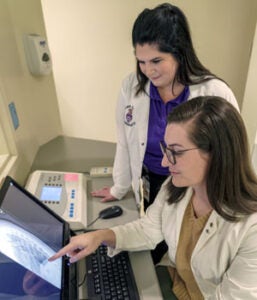 Emma Forlow, D.C. (Main, ’19) is taking on her next challenge: completing the three-year Radiology Residency at Palmer College, a program that will allow her to help chiropractic patients in a new way.
Emma Forlow, D.C. (Main, ’19) is taking on her next challenge: completing the three-year Radiology Residency at Palmer College, a program that will allow her to help chiropractic patients in a new way.
Dr. Forlow was first drawn to the chiropractic profession while she was pursuing her undergraduate degree in athletic training at Hope College. There she met a Doctor of Chiropractic who sparked her interest in the profession. When she started her career as a first aider providing care to athletes for the University of Michigan, she regularly interacted with physical therapists, medical doctors and Doctors of Chiropractic.
“The more I was around other professions the more I knew that I wanted to be a chiropractor. I visited Palmer and I immediately loved the campus and was impressed by the faculty and staff,” says Dr. Forlow.
She continued to work with athletes after graduating from Palmer, serving as an athletic trainer for local high schools. However, she was looking for a new challenge and returned to Palmer to pursue her Diplomate in American Chiropractic Board of Radiology (DACBR) status through Palmer’s Chiropractic Radiology Residence program.
“Radiology offered me a different and fun challenge,” she says. “I’m applying the knowledge I gained while going through Palmer’s curriculum and through my experience as an athletic trainer as I learn another way to diagnose.”
As a radiology resident, Dr. Forlow works under Ian McLean, D.C., DACBR, director of clinical radiology at Palmer College. Doctors of Chiropractic from all over the country send imaging to Palmer through the Palmer Imaging Consultation Services for the interpretation of X-rays, MRI and CT images. Dr. Forlow and Dr. McLean spend one to two hours every day reviewing cases as part of her training.
“Dr. McLean has been with Palmer for 35 years, and a huge part of my learning process is seeing how his mind works,” she says. “As part of the radiology review, Dr. McLean provides interpretation and patient management recommendations.”
“It’s important to understand that a lot of patients come in for help with back or neck pain, but they may have other health issues going on. Chiropractic radiologists play a crucial role in helping the chiropractor manage the patient, interpreting not just what’s on the X-ray, but what does that mean for the patient. We use imaging to rule out red flags, to look at disease processes, and we work with the rehabilitation department to correlate rehab findings with clinical findings.”
To students considering pursuing a degree in chiropractic she says “Do it, you’ll love it. There are so many different aspects of the chiropractic profession you can get into – research, radiology, pediatrics, sports and rehab.”
The Chiropractic Radiology Residency is a three-year post-graduate residency program that provides additional education and experience in chiropractic radiology and specialized imaging. Students who complete the Chiropractic Radiology Residency are eligible to sit for the board examination to earn diplomate status.
 Emma Forlow, D.C. (Main, ’19) is taking on her next challenge: completing the three-year Radiology Residency at Palmer College, a program that will allow her to help chiropractic patients in a new way.
Emma Forlow, D.C. (Main, ’19) is taking on her next challenge: completing the three-year Radiology Residency at Palmer College, a program that will allow her to help chiropractic patients in a new way.